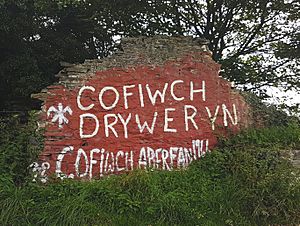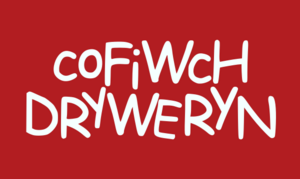- This page was last modified on 17 October 2025, at 10:18. Suggest an edit.
Cofiwch Dryweryn facts for kids
"Cofiwch Dryweryn" (pronounced "Kov-ich Druh-WEH-rin") means "Remember Tryweryn" in Welsh. It is a famous message painted on a stone wall in Wales. This wall is near a place called Llanrhystud in Ceredigion. A writer named Meic Stephens first painted these words in the early 1960s. He did this after Liverpool City Council decided to flood the Tryweryn Valley. This flooding created the Llyn Celyn reservoir. It also meant that a small community called Capel Celyn was lost.
The wall's message is very strong. It is also in a well-known spot. Because of this, and because it has been painted over and restored many times, it has become an important symbol in Wales. The phrase "Cofiwch Dryweryn" is now a popular slogan for Welsh nationalism. You can see it on T-shirts, banners, and even on other walls.
Contents
The Story of Cofiwch Dryweryn
Why Was Tryweryn Flooded?
In 1957, the city council of Liverpool wanted more water for its people. They decided to flood the Tryweryn Valley in Wales. This plan had approval from the UK Parliament. However, Welsh authorities did not agree with the plan. Most Welsh Members of Parliament also opposed it.
Local residents had many concerns. They asked the council for answers, but their questions were not properly addressed. People protested in Liverpool, London, and across Wales. Despite these protests, the valley was flooded in 1965. This created the Llyn Celyn reservoir. Sadly, several old communities, like Capel Celyn, were lost forever.
How the Famous Wall Message Began
Between 1962 and 1963, Meic Stephens was a Welsh writer and expert. He painted many slogans in the South Wales Valleys. As the flooding of the Tryweryn Valley was approaching, Stephens wanted to make a strong statement. He decided to paint "Cofiwch Tryweryn" on a rock. This phrase means "Remember Tryweryn" in Welsh.
He and his friend, Rodric Evans, searched for the perfect spot. They found a ruined cottage called Troed-y-Rhiw. Stephens spent about 15 to 20 minutes painting the message there. The original message had a small grammar mistake in Welsh. Later, when people restored the wall, they corrected it. The message now correctly reads "Cofiwch Dryweryn." This uses a Welsh language rule called a soft mutation.
Why 'Cofiwch Dryweryn' is So Important
The flooding of Tryweryn was a very important event for Welsh nationalism in the 1900s. After this event, many groups and political parties, like Plaid Cymru, gained more support. These groups wanted to protect Welsh culture and rights. The phrase "Cofiwch Dryweryn" became a powerful symbol for Welsh nationalism. Many people in Wales recognize this message.
In 2006, Meic Stephens said he chose the wall's spot by chance. He never thought it would become so famous. The wall's importance is clear because it has been damaged and repaired many times. There is also ongoing discussion about protecting it as a special Welsh landmark.


